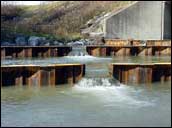When transportation agencies adopt environmental stewardship as the way they do
business, they can move from a reactive and regulatory-driven role to a proactive
and innovative role that demonstrates their environmental commitment. Environmental
stewardship empowers agencies and stakeholders to take advantage of opportunities
to incorporate environmental features into the entire transportation development
process. These opportunities can only be successful through internal and external
communication with agency staff and the public. By partnering with resource and
regulatory agencies, local municipalities, communities, non-profit organizations,
and industry, transportation agencies can develop high quality transportation
projects and efficient and effective environmental enhancements.
Benefits of Environmental Stewardship
- Expands environmental and community benefits.
- Helps the public view transportation projects and agencies as
environmentally friendly.
- Improves relationships with resource and regulatory agencies.
- Expedites permit approval and project review.
- Saves project development and mitigation costs.
- Improves project quality.
- Maximizes regulatory flexibility.
|
Effective Practices for Implementing Stewardship
- Integration of stewardship activities into planning, design,
construction, and maintenance.
- Outreach to determine stakeholder needs.
- Communication and partnerships with resource agencies and other
stakeholders to achieve common goals and pool resources.
- Monitoring of environmental commitments.
- Environmental management systems that promote environmental
consciousness in agency projects and processes.
- Support from upper management.
- Performance measures, continuous evaluation, and process improvements.
- Recognition of staff effectively implementing stewardship.
- Staff training and support.
- Adequate budget to meet goals.
|
The New York State Department of Transportation (NYSDOT) and the New Jersey
Department of Transportation (NJDOT) are currently integrating innovative environmental
stewardship practices into their daily business. NYSDOT's former environmental
manager is now its maintenance manager. This position helps to foster environmental
considerations throughout the entire transportation process. The following table
describes the goals, features, and implementation strategies used by NYSDOT and
NJDOT in their environmental stewardship initiatives. These initiatives can be
tailored by other states to meet their own unique needs.
 |
New York (NYSDOT)
www.dot.state.ny.us/eab/envinit.html |
New Jersey
(NJDOT)
www.state.nj.us/transportation/works/environment/overview.htm |
| Background |
NYSDOT began implementing its Environmental Initiative
in 1998. The initiative has dramatically changed NYSDOT's operations, processes,
and relationships with partners and stakeholders. |
As environmental concerns in communities grew, NJDOT
began promoting stewardship in 2001. |
| Goals |
- Promote and strengthen an environmental ethic throughout NYSDOT.
- Advance state environmental policies and objectives with NYSDOT resources.
- Partner with resource and regulatory agencies, local municipalities, non-profit
organizations, industry, and others to construct environmental enhancements.
- Develop environmentally sound transportation projects that meet community
needs with little disruption.
- Strengthen relationships with environmental agencies, organizations, and local
municipalities.
- Pilot new environmental protection and enhancement methods.
|
- Increase public outreach and involvement in the transportation process and
stewardship activities.
- Promote the use of context sensitive design principles.
- Improve New Jersey's environment and the quality of life of its citizens.
- Promote environmental practices in construction.
- Promote environmental stewardship among employees.
|
| Features of State Environmental
Stewardship |
- Incorporation of stewardship activities (wetlands creation and restoration,
stormwater retrofits, transportation corridor enhancements, etc.) from planning
to maintenance.
- Incorporation of environmental enhancements supported by other agencies, municipalities,
or groups into projects.
- Incorporation into construction and maintenance specific elements and design
features to prevent or mitigate adverse effects:
- Checklist to track environmental practices performed by maintenance staff
and crews.
- Senior environmental staff in all regional construction and maintenance units.
- Use of context sensitive design principles.
- Pilots to research methods to reduce toxins, improve air quality, increase
the use of recycled materials, etc.
- Information sharing and training with environmental agencies, organizations,
and local municipalities.
|
- Promotion of context sensitive solutions.
- Consideration of the environment in construction and maintenance.
- Environmental Management Practices field guide to assist construction crews.
- Permits online and accessible to contractors to foster compliance.
- Environmental plan sheets included in construction plans.
- Construction Authorization Environmental Inventory Form to track impacts and
mitigation.
- Regular erosion, sediment control, and hazardous waste project inspections.
- Compliance reviews of projects under construction.
|
| Implementation Steps |
- Revision of NYSDOT mission, procedures, and guidelines to incorporate environmental
stewardship goals.
- Incorporation of an environmental ethic throughout the entire transportation
process.
- Development and implementation of action plans.
- Formation of multi-disciplinary teams that investigate innovative environmental
elements.
- Tracking of activities by project and activity type.
- Regular meetings and partnerships with stakeholders.
- Staff training and handbooks.
|
- Appointment of Stewardship Action Group and environmental coordinators.
- Review of existing programs to identify opportunities for enhancements and
stakeholder consultation.
- Recommendation to management of stewardship elements to implement.
- Expanded public outreach and involvement.
- Reports and information sharing.
|
Contact Information
|
Jeanette Mar
FHWA New Jersey Division
840 Bear Tavern Road, Suite 310W
Trenton, NJ 08628
Phone: (609) 637-4203
Fax: (609) 538-4913
Email: jeanette.mar@fhwa.dot.gov |
Jeffrey Firmin
FHWA New York Division
Leo O'Brien Federal Building, 7th Floor
Albany, NY 12207
Phone: (518) 431-4125 X220
Fax: (518) 431-4140
Email: jeffrey.firmin@fhwa.dot.gov |
FHWA-AASHTO Environmental Stewardship Demonstration Projects
Twenty-two states have registered environmental stewardship demonstrations, including
NY and NJ. To learn more about these projects, visit:
www.stewardship.transportation.org
|
For more information on environmental streamlining, please visit:
www.fhwa.dot.gov/environment/strmlng/index.asp.
"Successes in Stewardship" is a Federal Highway Administration newsletter
highlighting current environmental streamlining practices from around the country.
To subscribe, contact Cassandra Allwell at (617) 494-3997 or allwell@volpe.dot.gov.

|



















